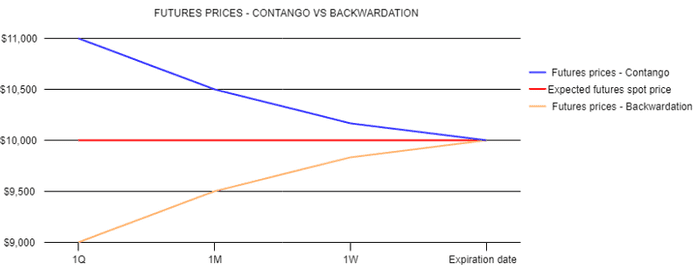ELI5: What Are Perpetual Futures?
You may have wondered — what are these perpetual futures that everyone are talking about? How do they work?
I have good news for you. Perpetual Futures are really not that much different from regular futures.
Perpetual Futures have a concept called funding, which sounds scary at first but is actually quite easy to understand once you have the basics down.
This article will try to explain the BTC Perpetual Future, but the concepts can be equally applied to any other Perpetual Future.
The three types of prices you must know
Let me start by introducing three different prices.
- Index Price. This is the spot price of BTC.
- Fair Price. This is the price of a BTC futures contract.
- Mark Price. This is the Index Price, plus some buffer.
The buffer is the difference between the Fair Price and the Index Price over the last X time intervals.
You can think of the Mark Price as a Fair Price that has been smoothed out.
Contango and backwardation
The Mark Price is usually different from the Index Price, as futures trade at either at a discount (also known as backwardation) or at a premium (also known as contango).
Mostly though, they trade at a premium.
They do this because of a concept called cost of carry.
You would rather buy 1 BTC at $20,000 in 1 year than you would buy 1 BTC at $20,000 now.
Why?
Hacks
Let’s say your Bitcoin wallet gets hacked during the next year and you lose all of your Bitcoin. In this case you’d be extremely happy that you didn’t buy your 1 BTC immediately, but waited with buying instead.
Delayed payment
You’ll also be delighted that you don’t need to spend $20,000 right now. You have a whole year to earn those $20,000.
Interest
Those $20,000 may generate a significant amount of interest over the next year. If you spend them now, you won’t be getting that interest.
Most people prefer to buy at a later date
Most people are happy to pay a premium for being able to buy at a later date. That’s part of the reason we have futures, and that’s why they usually trade at a premium.
The premium or discount will get smaller as we get closer to the expiration date of the future. At expiration, there will be no premium or discount and the Mark Price will equal the Index Price.

Funding
With perpetual futures, there is no expiry. This means that the premium could potentially be absolutely HUGE (we have absolutely no idea of the price of BTC in 20 years). How would you even set a price on a future like that?
So to price these in a sane way, we need some mechanism that will reduce the premium significantly, and do so on an ongoing basis.
That’s where funding comes in to play. Funding transfers money from the ones that are buying the future to the ones that are selling (if the future is trading at a premium) or from the sellers to the buyers (if the future is trading at a discount).
When you take these money transfers into account, the premium becomes much, much smaller.
I’d be happy to buy a future that will let me purchase 1 BTC at $20,000 whenever I want — and I’d be willing to pay a fat premium for that — but when I have to pay 0.02% of 1 BTC every 8 hours to the opposing short, as part of the deal, then I might just change my mind.
So the funding just ensures that the premium (or discount) is close to zero, and it does so by transferring money between the buyers (the longs) and the sellers (the shorts). This way the price of the BTC perpetual future stays extremely close to the spot price of BTC.

Calculation of Funding
If you’re interested in knowing how the funding rate (the percentage that will be transferred) is actually calculated, look into this explanation.
Usually you just take the difference between the Mark Price and the Index Price and apply a dampener and some scaling.
Conclusion
Futures trade at either a discount or a premium compared to spot. The premium becomes smaller as the future approaches expiry.
With perpetual futures, there is no expiry. This means that the premium (or discount) could potentially be HUGE. To make the premium (or discount) manageable, some money is regularly transferred between buyers and sellers. This is what we know as funding.
Funding eats into the premium, making it much smaller than it would be otherwise. In fact, the premium often ends up becoming 0. This is especially true if this exchange of money takes place every minute, as we see on some futures platforms.
So the purpose of funding is to eliminate this premium and make the price of the future (the Mark Price) aligned with the spot price (the Index Price).
If it wasn’t for funding, the price of a BTC Perpetual Future could be twice, 10 times or even 1000 times higher than the price of BTC.
